
Myrica is a genus of about 35–50 species of small trees and shrubs in the family Myricaceae, order Fagales. The genus has a wide distribution, including Africa, Asia, Europe, North America, and South America, and missing only from Antarctica and Oceania. Some botanists split the genus into two genera on the basis of the catkin and fruit structure, restricting Myrica to a few species, and treating the others in Morella.

Myrica faya is a species of Myrica, native to Macaronesia, and possibly also western coastal mainland Portugal.

Argyresthia pruniella, the cherry fruit moth or cherry blossom tineid, is a moth from the family Yponomeutidae, the ermine moths.

Canararctia is a monotypic tiger moth genus in the family Erebidae erected by Vladimir Viktorovitch Dubatolov in 1990. Its only species, Canararctia rufescens, was first described by Gaspard Auguste Brullé in 1836. It is endemic to La Gomera and Tenerife in the Canary Islands.

Scythropia crataegella, the hawthorn moth, is a species of moth in the monotypic genus Scythropia. It is found in western Eurasia.

Argyresthia albistria is a moth of the family Yponomeutidae. It is found in most of Europe.
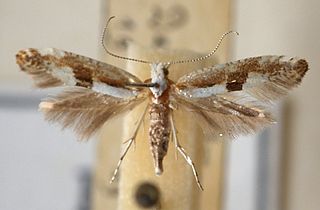
Argyresthia bonnetella is a moth of the family Yponomeutidae. It is found in Europe. The wingspan is 9–11 mm. The head is white. Forewings are shining ochreous-whitish, usually strigulated and sometimes discally suffused with ferruginous brown; a suffused ferruginous -brown median longitudinal streak from base to before middle; a curved dark ferruginous- brown fascia from middle of dorsum to 4/5 of costa, sometimes obsolete except on dorsum. Hindwings are grey. The larva is yellow-green; head and plate of 2 brown.
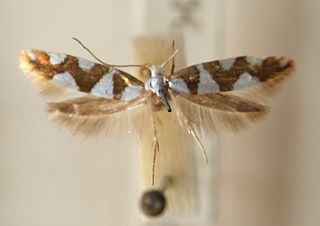
Argyresthia brockeella is a moth of the family Yponomeutidae. It is found in Europe, east Siberia and Japan. The wingspan is 9–12 mm. The head and thorax are white. Forewings are deep coppery-golden; a spot on base of dorsum, a fascia at 1/3, three posterior semioval costal spots and a larger tornal spot shining white; sometimes the fascia is connected with adjacent costal and dorsal spots. Hindwings are grey. The larva is pinkish-brown; head brown; plate of 2 partly blackish-edged.
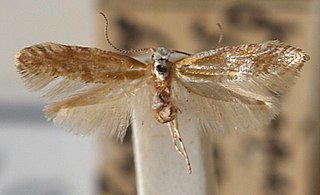
Argyresthia dilectella is a moth of the family Yponomeutidae. It is found in Northern Europe and Central Europe.

Argyresthia goedartella, the bronze alder moth, is a species of moth of the family Argyresthiidae.

Argyresthia semitestacella is a moth of the family Yponomeutidae. It is found in Europe.
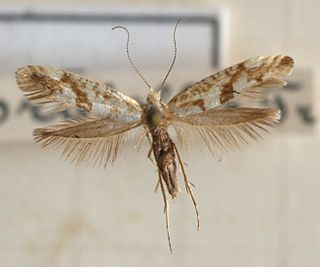
Argyresthia sorbiella is a moth of the family Yponomeutidae. It is found in Northern Europe and Central Europe.

Argyresthia spinosella is a moth of the family Yponomeutidae. It is found in Europe and Anatolia.
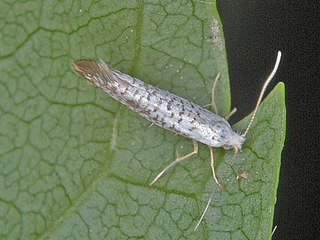
Argyresthia retinella is a species of moth of the family Yponomeutidae.
Strepsicrates smithiana, the bayberry leaftier moth or Smith's strepsicrates moth, is a moth of the family Tortricidae. It was first described by Lord Walsingham in 1891. It is native to southern North America, south to South America, including Florida, Texas, Georgia, Dominican Republic, Puerto Rico, Cuba and the Galapagos Islands. It was introduced to Oahu, Hawaii, in 1955 to aid in the control of Myrica faya.
Phyllonorycter myricae is a moth of the family Gracillariidae. It is native to Madeira and the Canary Islands. In 2000, it was studied in Hawaii as a potential biological control agent for Myrica faya.
Caloptilia bistrigella is a moth of the family Gracillariidae. It is known from Flores in the Azores.
Argyresthia tatrica is a moth of the family Yponomeutidae. It is found in the Tatra Mountains in Slovakia.

Calliteara fortunata is a moth of the family Erebidae first described by Alois Friedrich Rogenhofer in 1891. It is found on the Canary Islands.

Acleris lipsiana is a species of moth of the family Tortricidae. It is found in Great Britain, Spain, France, Belgium, the Netherlands, Germany, Denmark, Austria, Switzerland, Italy, the Czech Republic, Slovakia, Hungary, Poland, Greece, Norway, Sweden, Finland, the Baltic region and Russia. It is also found in North America, where it has been recorded from Alberta and Washington. The habitat consists of high moors and mountainous areas.















